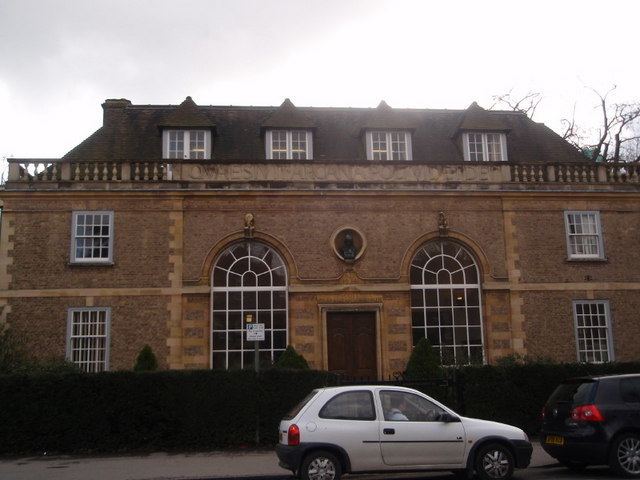Established 1920 (1920) Phone +44 1223 336540 | Website www.spri.cam.ac.uk Founded 1920 | |
 | ||
Location Cambridge, United Kingdom() Address Lensfield Rd, Cambridge CB2 1ER, UK Hours Closed today SaturdayClosedSundayClosedMonday9AM–1PM, 2–5:30PMTuesday9AM–1PM, 2–5:30PMWednesday9AM–1PM, 2–5:30PMThursday9AM–1PM, 2–5:30PMFriday9AM–1PM, 2–5:30PMSuggest an edit | ||
Scott polar research institute centenary of scott reaching the pole
The Scott Polar Research Institute (SPRI) is a centre for research into the polar regions and glaciology worldwide. It is a sub-department of the Department of Geography in the University of Cambridge, located on Lensfield Road in the south of Cambridge (52°11′54.40″N 0°07′34.45″E).
Contents
- Scott polar research institute centenary of scott reaching the pole
- Scott polar research institute mov
- Purpose
- The Polar Museum
- Research
- Glaciology and Climate Change Group
- Glacimarine Environments Group
- Polar Landscape and Remote Sensing Group
- Polar Social Science and Humanities Group
- References
Scott polar research institute mov
Purpose
SPRI was founded in 1920 as the national memorial to Captain Robert Falcon Scott and his companions, who died on their return journey from the South Pole in 1912. It investigates issues relevant to the Arctic and Antarctic in the environmental sciences, social sciences and humanities. The institute has some 60 personnel, consisting of academic, library and support staff plus postgraduate students, associates and fellows attached to research programmes.
The institute also hosts the secretariats of the International Glaciological Society and the Scientific Committee on Antarctic Research, and is part of the NERC Centre for Polar Observation and Modelling.
The Polar Museum
SPRI operates the Polar Museum, which features artefacts (particularly from the heroic age of exploration), paintings, drawings, photographs (which includes cinematographic film, lantern slides, and daguerreotypes), and other material relating to polar history, exploration, science and art.
In 2010 the renovated Polar Museum opened its doors to the public. It now displays more of its collections than before. The new displays are based on the theme of exploration into science, emphasising both the history of exploration of the Arctic and Antarctic and the wider environmental significance of the poles in a changing world.
Art and artefacts from the people who call the Arctic home are displayed alongside the last letters of Captain Scott and iconic Antarctic photographs by Herbert Ponting. A series of exhibits shows how science is undertaken in the harsh conditions of the polar regions.
As well as these permanent exhibits, the Museum regularly hosts special exhibitions and shows of modern polar art. The Museum is open Tuesdays to Saturdays, admission is free.
Outside the institute stands a monument of British oak to those who lost their lives in Antarctica in pursuit of science. It was unveiled on 12 May 2011 by the sculptor, Oliver Barratt and Roderick Rhys Jones (Chairman of the British Antarctic Monument Trust). The monument represents the mould from which a stainless steel needle has been cast; the needle was erected at Stanley on the Falkland Islands.
The Museum is one of the eight museums which make up the University of Cambridge Museums consortium.
Research
SPRI has several research groups.
Glaciology and Climate Change Group
This group's work involves quantifying the state of the cryosphere using remote sensing by satellites, plus accurate field measurements and computer simulations, to understand the processes in detail. In particular, the group has been able to observe the melting of the Larsen Ice Shelf, the rapid retreat of ice in western Antarctica, and increased summer melting in northern Canada. This work has contributed greatly to understanding climate change.
Glacimarine Environments Group
This group's work focuses on the dynamics of ice-sheets and delivery of sediment to the marine environment. The group uses geophysical and geological evidence gathered by icebreakers in the polar seas.
Polar Landscape and Remote Sensing Group
This group's work focuses on the processes which modify the polar and sub-polar environments, such as Arctic vegetation, and snow and ice cover. Improving techniques for measuring vegetation from satellite data is an important part of the work.
Polar Social Science and Humanities Group
This is an interdisciplinary group covering the anthropology, history and art of the Arctic. Its work includes looking at politics and environmental management in the polar regions, with particular expertise in the religion, culture and politics of the Russian North.
